
Original Link: https://www.anandtech.com/show/2771
We were speaking with MSI a few weeks ago about their upcoming product plans and one item stood out in the conversation. No, it was not the excellent 790FX-GD70 motherboard that has earned our admiration and soon our praise, nor was it the new N260GTX-Lightning Black Edition GTX 260 video card or their updates to the Wind Netbook line. Now, all of these and some we cannot discuss are actually very interesting products for their market segments. However, when we heard X58 and $150 in the same sentence, our ear lobes tweaked and sly smiles developed on our faces. We were told that MSI was hard at work on delivering an X58 motherboard as close to the $150 mark as possible.
We thought this idea was really interesting and certainly made sense when looking at the current Intel product lineup - a lineup that currently means either going Socket 775 and buying into the P45 chipset in the $85~$130 range or smartly bypassing the now defunct X38/X48 lineup for the X58 product along with its processor and RAM upgrade requirements. The mere mention of X58 typically means a $300 ringtone goes off in our minds. Lately, that ringtone has become softer as several boards are available in the sub $200 range including MSI’s X58 Pro and various models from ECS, Foxconn, DFI, and Gigabyte.
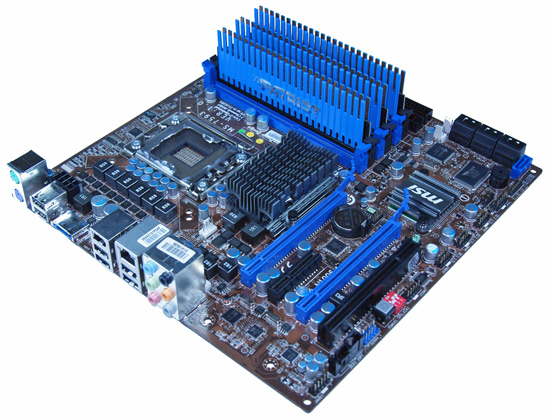
Well, MSI tried their best to hit the $150 mark and might still make it if rumored price cuts on the X58 hold true in the near future. The board MSI is targeting into the entry level X58 market is the X58M and it arrives in a uATX form factor with an MSRP of $169.99. It's close to the eventual $150 price point but this motherboard is anything but entry level in many ways. The board features the X58 IOH, ICH10R with six 3Gb/s SATA ports, JMicron JMB363 for an additional 3GB/s SATA port, IDE support, and an eSATA port. Also included from the land of Crabs is the Realtek ALC 889 HD audio codec and RTL8111C Gigabyte LAN. MSI even tossed in IEEE 1394a support along with a great layout and overclocking friendly BIOS backed up by some excellent electrical components.
We are starting to see significant interest in the uATX form factor again in the higher end SFF market. In fact, the Core i7 runs cool enough and draws low enough voltage that a user can design a top performing multi-use system around this combination. We expect to see several new uATX designs when P55 hits the market later this year, if not mini-ITX designs based around it. As such, the MSI X58M joins the DFI LANParty JR X58-T3H6 and ASUS Rampage II GENE in the current X58 uATX market, with others set to join shortly.
We are providing a first look at the X58M today, with the goal of providing enough information on the board to make an informed purchasing decision before we complete our next X58 roundup. So, let’s look at the board and initial performance results and see if we have a Mighty Mouse or Mallrat on our hands.
MSI X58M - Feature Set
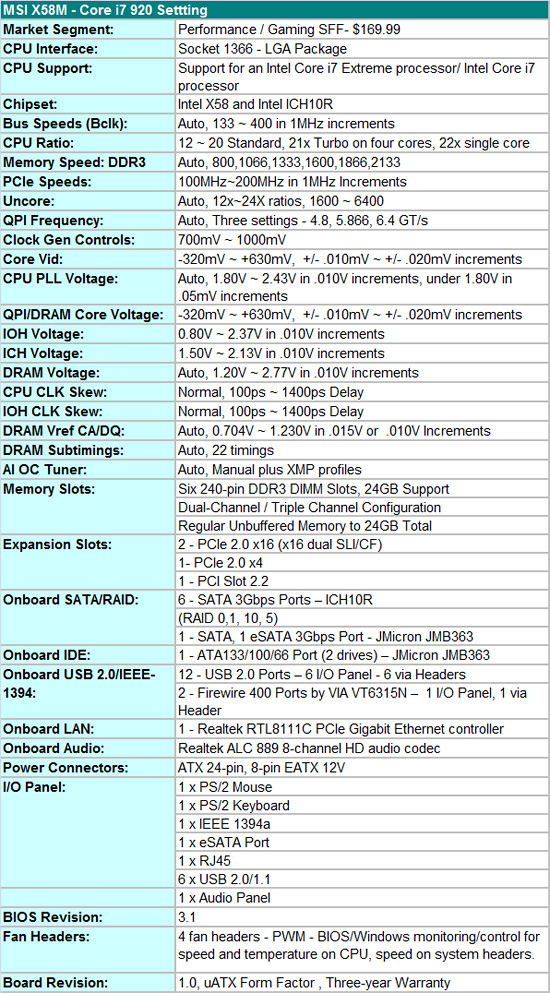
MSI includes the standard array of components like the Realtek ALC889 HD audio codec, Realtek RTL8111C, VIA VT6315N IEEE 1394a chipset, JMB363 chipset for eSATA, IDE, and SATA, Intel ICH10R for SATA and RAID, along with full support for the Core i7 processor series. With the latest 3 series BIOS, the board fully supports both CrossFire and SLI operation.
MSI also includes an accessories bundle. You get the standard rear I/O panel cover along with 1 x IDE cable, 1 x SATA cable, 1 x USB expansion bracket, and an external Molex power cable. MSI provides a well-written and informative manual and software CD.
BIOS
MSI has a well optioned BIOS that belies the fact this is an "entry level" X58 motherboard. The BIOS is set up for the general enthusiast and includes all the settings one needs to get the most out of this motherboard. Two strengths of the BIOS are the abundant voltage settings and memory timing options. For those who do not wish to tinker that much, MSI provides several auto overclocking options that can take the guesswork out of most of the BIOS settings. We found that these settings will get you about 90% of the way there when overclocking.
We did have a couple of slight disappointments with the BIOS. In the voltage setting options, MSI does not disclose the base voltages that the board defaults to at startup, instead offering a possible range in the text field descriptions. Speaking of the text fields, MSI did a good job on explaining several of the settings and voltage ranges, but inexplicably left out these descriptions in other areas. Our other complaint has to do with the limited control over the CPU and System fan headers. The CPU fan header can be set to control fan speed based on temperatures and the system number one fan header offers three speed adjustments, but the two chassis headers offer nothing in the way of control.
There's a bit more good news and bad news on the BIOS front. There are six Overclocking profiles and M-Flash actually works. We flashed our BIOS twenty five times without an incident, though we still feel safer flashing from a DOS boot disk. MSI also provides their GreenPower technology on this board that allows the BIOS to dynamically control the number of power phases in operation based on load if the CPU Phase control option is enabled. The bad news is that while S3 resume and wake on USB work perfectly, but only up to around 150 Bclk speeds. They system would not resume properly with the Bclk set higher than ~150 in our testing. MSI is working diligently to fix this problem. Other than that, we were very impressed with the BIOS.
Software
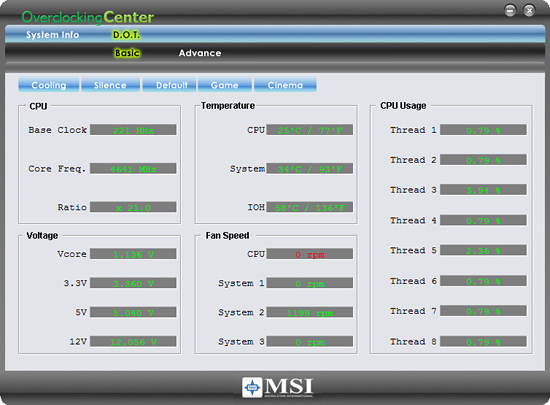
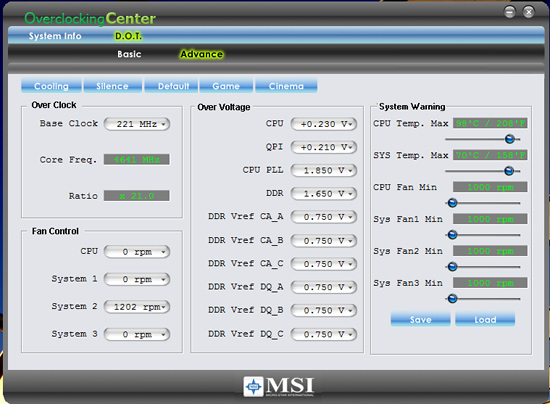
MSI’s Overclocking Center application provides monitoring, system information, and basic overclocking capabilities. This application has a come a long way in the past few months but is still a step or two behind Gigabyte’s EasyTune6 and EVGA’s ELeet applications; still, it provides a reasonable number of options and controls. This application is useful for extracting a decent amount of performance improvement out of the system after booting into Windows via the four basic voltage setting changes (really about all you need for i7 in most cases) and Bclk changes up to 265MHz. One benefit of such an approach is that you can reduce or increase performance - along with power requirements and the stress on a system - without rebooting. MSI also provides some presets for various system setups and the ability to save profiles. We did find that the application would not properly identify several four-pin CPU fans.
DPC Latency
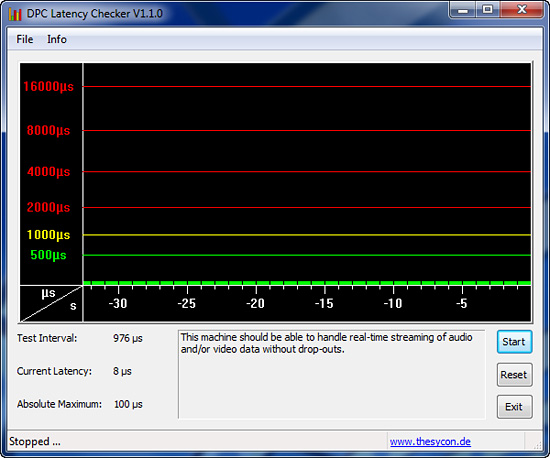
We receive a lot of requests for DPC latency results on each board we test. The MSI X58M passed with flying colors using our stock settings at 21x133, but with 12GB of memory at DDR3-1600 at 8-8-8-24 1T timings.
Board Layout
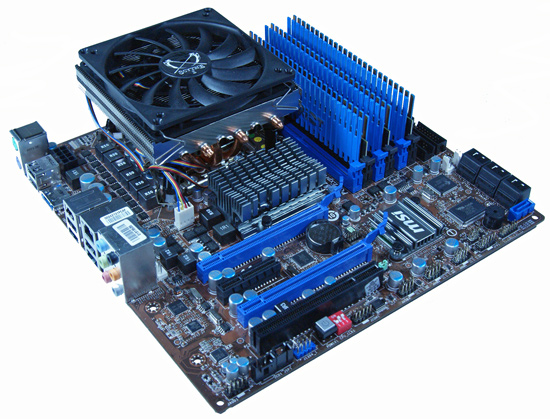
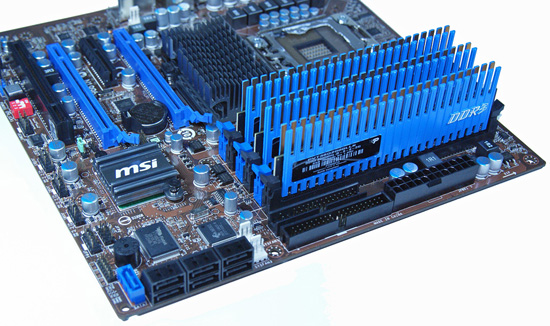
Taking a quick tour around this board, we find the overall layout is very good. MSI placed the 24-pin and 8-pin ATX power connectors, floppy/IDE connectors, and the SATA ports near or along the edge of the motherboard. We would have preferred that MSI drop the floppy connector altogether and utilize the space for the two chassis headers. These two fan headers are extremely difficult to utilize with a double slot card like the GTX260 216 or HD 4890 inserted in the first PCIe x16 slot. The rear of the video card covers the fan headers and depending on the card, the first header might not be usable.
A couple of other items we would like to see changed is the color of the PCB and the removal of the Overclocking Block Switch next to the Power On button. Considering MSI’s latest blue on black color scheme for their performance oriented boards, the blue/black on a brown PCB just does not look right on this board. However, in order to meet cost targets this was one of the areas that had to suffer and in the end color really does not affect performance. As far as the overclocking block, we could not find a single opportunity where it provided an advantage over changing Bclk in the BIOS. We think the space could be better utilized for a reset button or clear CMOS button - or both to be honest.
Installation of our peripherals was easy and the board fit well in several case designs. One important item worth mentioning is that our larger air coolers like the Vigor Monsoon III LT fit fine on the board and did not block the first DIMM slot as it does on the ASUS Rampage II GENE board. The back of the board is clean and all of our various air coolers that require a back plate worked fine. Let’s take a quick look at the rest of the board.
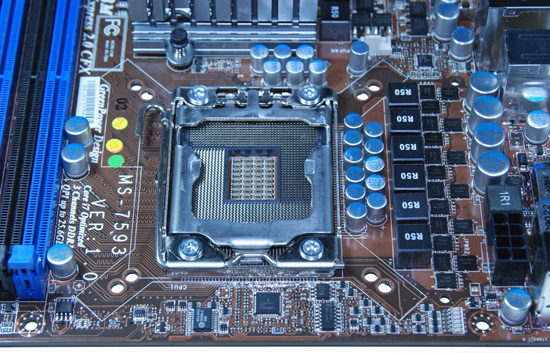
The CPU socket area is open and unobstructed for the most part. The socket area is surrounded by the IOH heatsink, MOSFETs, and several capacitors, but we had no issue installing large air coolers or a couple of water blocks. This board features a 6-phase power design with three Low RDS(on) MOSFETs per channel along with the R50 ferrite core closed chokes. The MOSFETs are not passively cooled, though mounting holes are provided on the board if you happen to have a knack for making your own or have an old Eclipse board lying around. We highly suggest active cooling in this area if you are overclocking to ensure stability and longevity. The board features cooling mounting holes for both the LGA775 and LGA1366 heatsink designs. MSI also provides a six light LED setup below and to the left of the 8-pin ATX power connector that indicates the number of power phases in use.
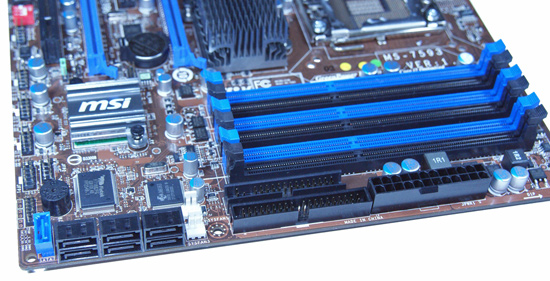
The floppy drive connector, IDE connector, and 24-pin ATX power connector are located along the edge of the board behind the memory slots. Moving to our left, we have the two chassis fan headers that potentially can be blocked by most two slot video cards. Intel’s ICH10R provides support for the six black SATA ports and features RAID 0/1/5/10 capabilities with Intel’s excellent Matrix technology. JMicron’s JMB363 powers the blue SATA7 slot and the eSATA port on the I/O panel. The ICH10R is cooled by a low-rise aluminum heatsink . Along the left edge of the board is the front panel connector, USB 2.0 headers, and IEEE 1394a header.
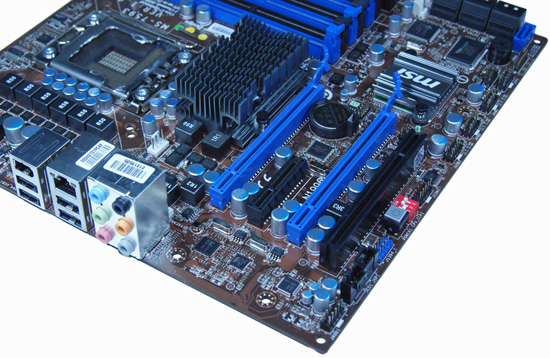
The expansion slot layout is good considering the limited space. The PCIe x4 slot and PCI slot become physically unusable if dual-slot graphics cards are placed in the PCIe x16 slots. A low-rise aluminum heat sink covers the X58 chipset and provided decent but not spectacular cooling when overclocking. We noticed IOH temperatures hitting 86C when overclocking the board and providing 1.15~1.20V to the IOH to reach Bclk speeds above 220. During normal operation, the IOH temperature fluctuated between 46C~54C. This is another area that could use active cooling from your case fans or a small 40mm fan for heavy overclocking situations.
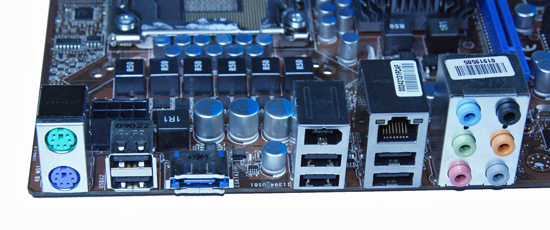
Last but certainly not least is the I/O panel. There are the standard issue PS/2 keyboard and mouse ports, Gigabit LAN port with LED activity lights, six USB 2.0 ports, one IEEE 1394a port, one eSATA port, and an audio panel.
Test Setup
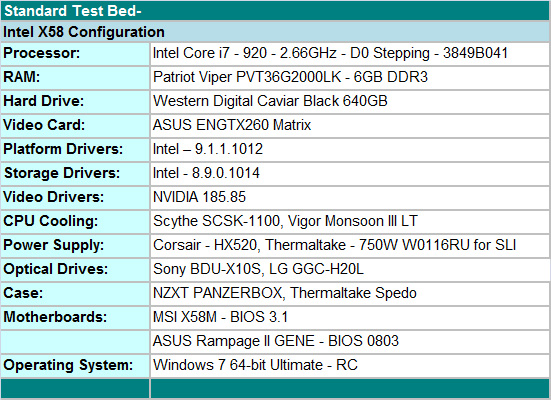
We selected the ASUS ENGTX260 video card for GPU duties. It is a non-reference design that offers improved thermals and acoustics over the standard NVIDIA GTX 260 216 designs. The WD Caviar Black 640GB is our hard drive of choice for storage purposes. LG’s GGC-H20L and Sony’s BDU-X10S Blu-ray playback capable drives fills in for optical duties. We purchased Patriot’s impressive DDR3-2000 C8 6GB kit for memory duties. This kit features the Elpida Hyper ICs that are required at this point for high memory clocks with low voltages. We used 6GB in our standard benchmarks with the memory speed set to DDR3-1600 and 7-8-7-20 1T timings at 1.6V. We chose the Scythe SCSK-1100 for our standard air-cooling results and for overclocking up to the 160 Bclk range. This cooler features a low profile design with quiet operation and good cooling characteristics, which is perfect for a basic SFF setup. Vigor Gaming provided their Monsoon III LT CPU and we utilized it for our 200 Bclk and up testing.
Our standard power supply is the excellent Corsair HX520, and considering our standard test bed is limited to a single video card this power supply works perfectly. We did toss in the Thermaltake W0116RU 750W for SLI testing since it supports the necessary PCIe connectors. NZXT sent us the new PANZERBOX case that really turned out to be an excellent pairing with our uATX setup. We decided to try some extreme air based overclocking and turned to the Thermaltake Spedo for additional airflow opportunities in our 21x230 test setup. We utilized the ASUS VH242H 23.6" 1920x1080 LCD monitor for display duties. Finally, we have dropped Vista 64-bit and moved to the Windows 7 64-bit RC for our testing today - it just works better.
Overclocking
MSI advertises the X58M as an entry level - maybe even mainstream - X58 motherboard and will nudge users towards their enthusiast level Eclipse series for overclocking duties. Well, we disagree with them as this board to date has overclocked just as well as their upper end X58 offerings. There are definitely boards that will hit higher Bclk rates and offer better memory clocking, but we are concentrating on mainstream overclocking abilities in our tests. We focus on the type of overclocks that support 24/7 operation with reasonable cooling and the ability to run a multitude of programs without a problem. We are not optimizing for SuperPI or 3DMark records, though that would provide an interesting twist.
We put an emphasis on stability during our testing sessions so we test with real world applications ranging from a variety of games to digital imaging software to various audio/video creation programs, along with the typical OCCT and PCMark Vantage tests.
i7 920 D0 6GB Results
MSI X58M
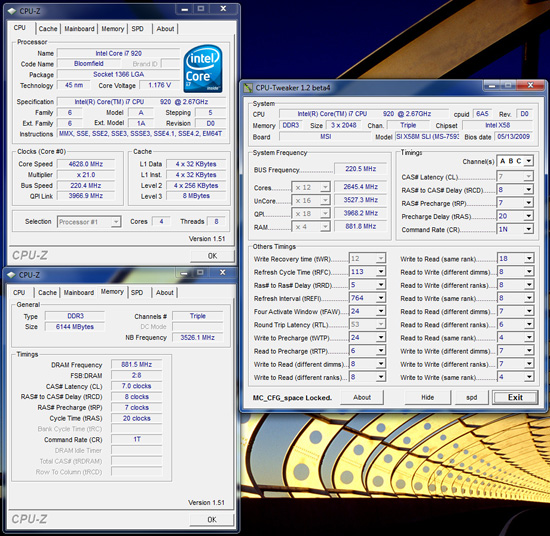
ASUS Rampage II GENE
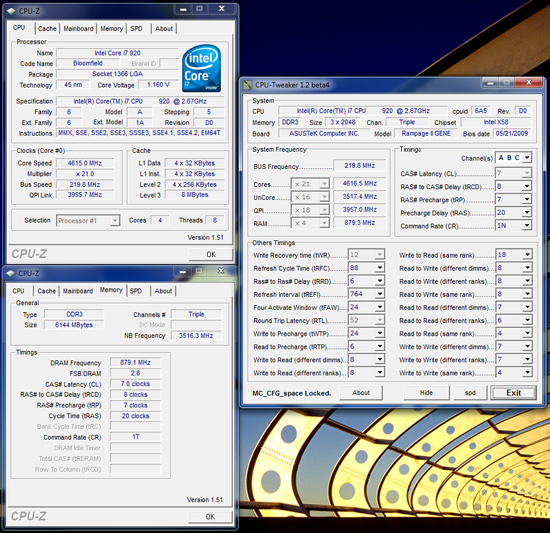
Our maximum 24/7 overclock on air-cooling with the i7 920 D0 resulted in a 4.62GHz clock speed at a respectable 220 Bclk with our 6GB Patriot memory kit set to DDR3-1760 at 7-8-7-20 1T timings. The primary voltage settings were 1.36V Core VID, 1.38V VTT, 1.85V PLL, 1.65V VDimm, and PCIe at 105MHz. We also enabled MSI’s CPU Phase control and basic power management options so idle Core VID voltages ranged from 1.152V ~ 1.176V. Now, we did find that MSI overvolts VTT so our 1.38V setting would idle around 1.4025V~1.41V but under load would drop to 1.387V on average. Core Vdroop was approximately -.02V with Load Line Calibration (LLC) disabled and is our recommended setting. We do suggest that users provide proper cooling to the PWM area at these overclock rates as the MOSFETs require additional airflow due to the lack of passive cooling via heatsinks.
Our second screenshot is the same component setup with the ASUS Rampage II GENE motherboard sporting the new 0804 BIOS. On the ASUS side, we had to set voltages at 1.36V Core VID, 1.43V VTT, 1.85V PLL, 1.66V VDimm, and PCIe at 107MHz to obtain the same clock rates. The primary difference is the slight increase in VTT required on the ASUS board and increase in PCIe rates for stability. This board has also had problems with the LAN dropping out when increasing PCIe rates above 101 and it continues to be a challenge for us. The good news is that the LAN will not drop with PCIe rates above 110 at stock Bclk rates now, but it still has a tendency to drop when overclocking. ASUS continues to work on it.
Also, each manufacturer takes a different approach to memory sub-timings as ASUS sets tRFC to 88 compared to 113 for MSI, tRRD is 6 for ASUS and 5 for MSI, and RTL is 52 for ASUS and 53 for MSI. Memory performance slightly favors ASUS - though our SuperPI 32M numbers favor MSI at this setting: 08m 02.406s compared to 08m 04.817s for ASUS. These are non-optimized results on Windows7 64-bit with a full software load and all services running.
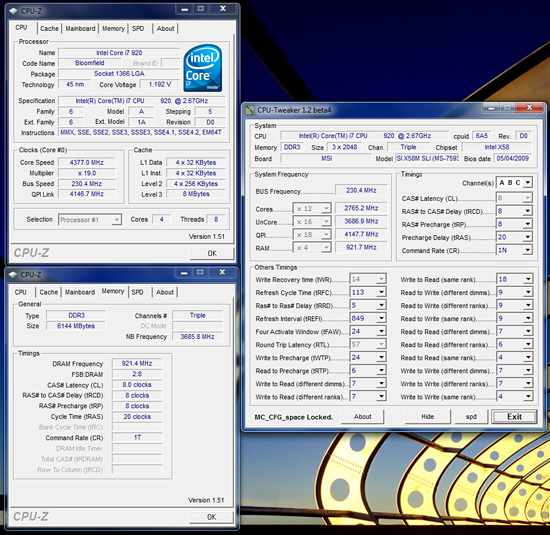
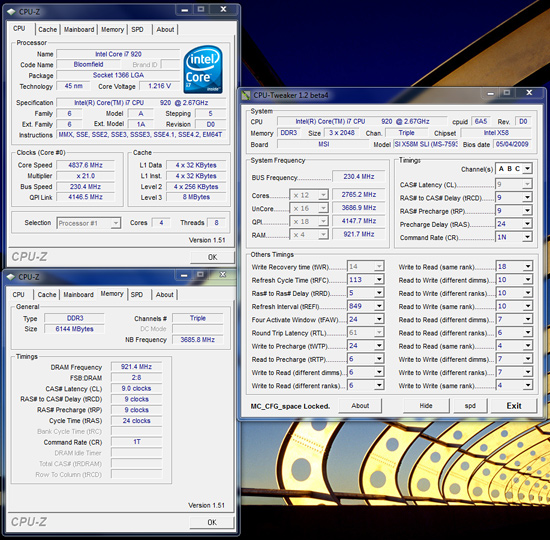
Our maximum stable Bclk speed on the X58M board with air cooling is 230. We could boot from BIOS with either 19x230 or 21x230 configurations. Our 19x230 setup had our voltage settings at 1.30V Core VID, 1.42V VTT, 1.85V PLL, 1.70V VDimm, and PCIe at 110MHz. This resulted in a 4.37GHz core speed and memory speed of DDR3-1842 at 8-8-8-20 1T timings for a 24/7 stable setup, although we see no real reason for running Bclk speeds at this rate except for benchmarking.
We cheated on our 21x230 configuration, as we had to strap a couple of small ice packs (the type used for joint problems) onto the Vigor Monsoon III LT in order to run our benchmarks. In fact, one icepack would only allow us to complete a three-loop run of PCMark Vantage or 3DMark Vantage. However, it just indicates to us that with additional cooling the X58M motherboard provides a very stable platform for aggressive Bclk rates on a uATX form factor board. In case you are wondering, the board just would not POST at anything higher than 235 Bclk even with the CPU ratio set to 12x. In addition, we just could not get our particular Rampage II GENE board stable at a 230 Bclk setting but ended up with an iron clad 19x228 setting at the same voltages dialed into the MSI board.
i7 920 D0 High Clock Low Volt Results
While overclocking is an important and fun measurement of a board’s capabilities, we also realize that undervolting can be just as important to others. As such, we devised a quick multitasking test that allows us to really push our systems with real world applications that stress the GPU, CPU, memory, and storage subsystems. We load up Sony Vegas Pro 9.0 64-bit and set it to transcode a 1080p video while running our Far Cry 2 loop benchmark at 1680x1050 2xAA DX10 High Quality in window mode. Average CPU usage is 98% throughout this process with HT enabled.
MSI X58M
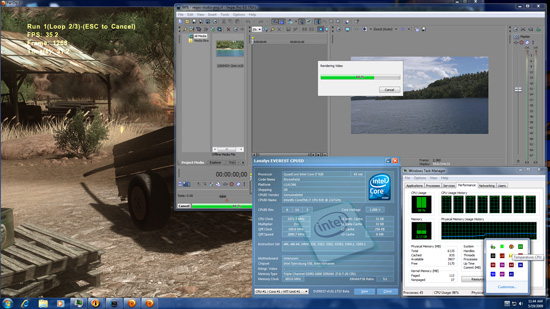
ASUS Rampage II GENE
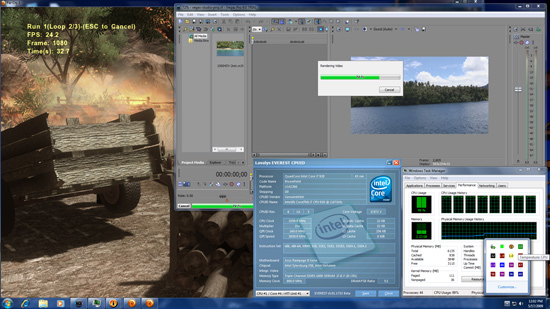
Both boards passed this benchmark and our full test suite at 21x160 for a final 3.37GHz core speed. We enabled the MSI BIOS with full power management options and Core Vid at a -0.100mV offset resulting in an idle voltage of 0.840V and full load voltage of 1.008V. VTT was set to 1.2V and VDimm at 1.60V with memory timings at 7-8-7-20 1T for DDR3-1600 speeds. The ASUS BIOS was also set with all power management features enabled with Core VID at 1.006V and no offset since a negative value is not available on the ASUS board. The load voltage for the ASUS board was 0.972V with VTT at 1.2V and VDimm at 1.60 with the same memory timings as the MSI board.
At stock settings (21x133) we were able to run the MSI board at 0.740V and the ASUS at 0.800V in a wide variety of applications and benchmarks with the same memory timings and settings above. Of course, the quality of the CPU has a significant impact on these results but so far, our four different D0 lot codes have performed equally in low volt testing on both of these boards.
Thoughts
We only have a single concern about recommending this board for 24/7 overclocking use. As mentioned, S3 resume does not work properly with Bclks above 150 or so at this time. If that is a deal breaker for you, then we suggest waiting to see if/when MSI resolves the problem or look at the DFI or ASUS uATX boards. However, they also have various quirks like the LAN dropout on the ASUS board with PCIe speeds over 101 or abnormally high VTT requirements on the DFI board with our D0 stepping processors. Once we have final BIOS releases from each manufacturer, we will complete our uATX roundup with the boards. For now, the MSI X58M is an excellent choice for your overclocking (with proper board cooling) or undervolting needs in this market sector. Our gallery has additional overclocking results and screenshots at a variety of settings.
General Performance – PCMark Vantage
Futuremark's PCMark Vantage x64 is probably the single most diverse set of benchmarks that can be run on a system to mimic real world usage scenarios. The TV and Movies, Gaming, and Music Suites can be frighteningly difficult to pass when a system is not set up correctly. We've had boards in the labs that will pass hours of Prime95 torture testing or OCCT that fail even the basic 30 minute run of PCMark Vantage, let alone the full 1 hour and 30 minute test run that we loop five times.
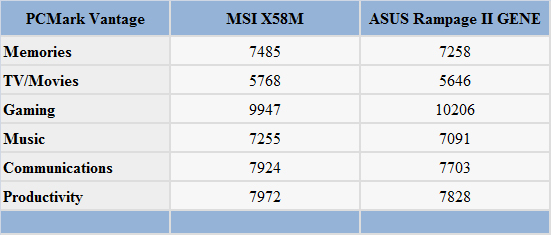
These test results surprised us, to the point where we ran the benchmark twenty five times on each board and across each of three different BIOS releases looking for an explanation. Historically, ASUS does very well in the gaming and 3D benchmarks which is evident in the gaming benchmark suite, but performance in the other test suites is different from previous results. We fired up our application benchmarks from the full review test suite and in each case, the MSI X58M had a slight advantage in applications ranging from Sony Vegas Pro 9.0 to Adobe Photoshop CS4. So, advantage to MSI in our general performance benchmarks.
General Performance – Multitasking
We devised a quick multitasking test that allows us to stress test these platforms with real world applications that simultaneously utilize the GPU, CPU, memory, and storage subsystems. We load up Sony Vegas Pro 9.0 64-bit and set it to transcode a 1080p video while running our Far Cry 2 loop benchmark at 1680x1050 2xAA DX10 High Quality in window mode. Average CPU usage is 98% throughout this process with HT enabled. We also capture the total system power draw at the wall less the monitor and keep track of Core 1 temperatures via Everest 5.01. We tested at 21x160 (3.3GHz) since this setting is basically a free overclock with our setups as voltages do not need to be increased - in fact, we actually lowered core vid slightly from the auto setting of 1.080V.
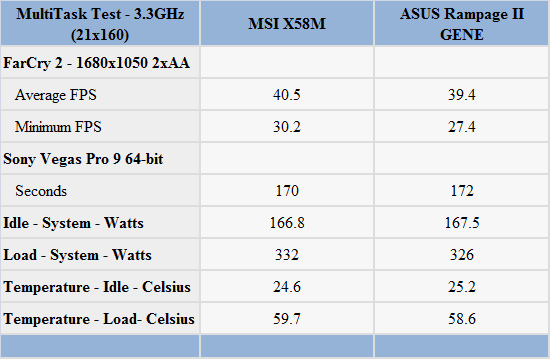
The MSI X58M’s performance numbers were just ahead of the ASUS board in both the frame rate measurement and the time it took to complete the 1080p transcode. Both boards were extremely stable and neither one failed during 25 iterations of this benchmark. Ambient temperatures were at 21C during testing.
The MSI board holds a slight advantage in idle wattage since the Core i7 920 is idling at 0.840V compared to 1.006V for the ASUS board due to differences in the BIOS setup. At full load the 920 is drawing 1.008V on the MSI board and around 0.972V on the ASUS board, once again due to BIOS differences in how Core Vid is applied with power management features enabled. This results in a slightly lower system draw for the MSI at idle and higher than the ASUS at full load with temperatures following the same pattern.
If we enable ASUS’s iTracker software on their GTX 260 Matrix card and set the profile to power savings, our system idle numbers dropped to 159W and load ranges to 310W on both boards. These are excellent numbers for a top tier performance setup considering our case and component choices.
Gaming Performance – Far Cry 2
This title has beautiful graphics, an open ended environment, and is fun to play. If you dial up the graphics options, the game rewards with you some fantastic visuals courtesy of the Dunia Engine. The game also features the most impressive benchmark tool we have seen in a PC game. We set the performance feature set to Very High, graphics to High, and enable DX10 with AA set to 2x. The in-game benchmark tool is utilized with the Ranch Small level and we report an average of three test runs.
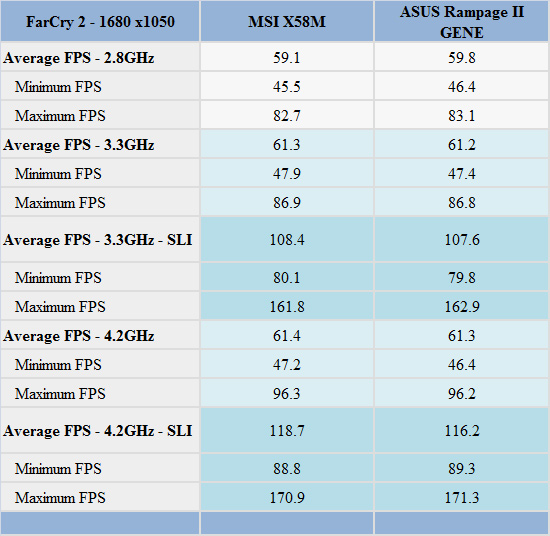
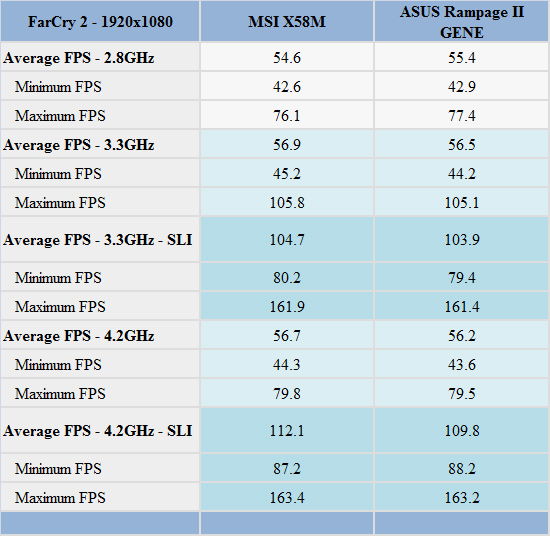
We have always applauded ASUS for their strong graphics results in a variety of tests and our PCMark Vantage test revealed their particular strength in the gaming test. We see the ASUS board continuing this pattern in the stock core speed with single card results. Interestingly enough, once we raise the core clock speed or introduce SLI into the equation, the MSI X58M generates better results. The differences are minimal but for the first time in recent memory, we do not see ASUS winning this particular benchmark.
Storage Performance – PCMark Vantage
PCMark Vantage is the latest system benchmark available from Futuremark, and is specific to Windows Vista and now Windows 7. Similar to the venerable PCMark05 in its makeup, Vantage modernizes the criteria and test methodology to reflect what users may encounter when running the new Windows OS and current applications. The total HDD benchmark is roughly 87% reads and 13% writes in nature. We run each test five times per drive, producing a median score that we use for comparison in our charts. We enable AHCI settings for each board and downloaded the latest Win7 driver set from Intel.
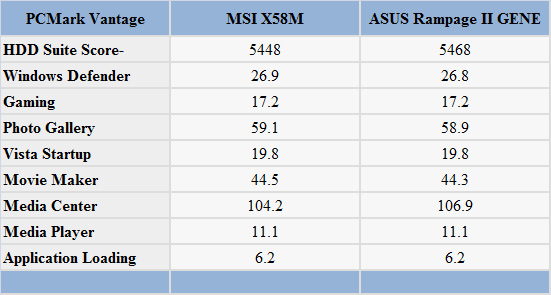
The ASUS scores slightly higher on the total suite score due to a stronger performance in the Media Center test. Otherwise, the two boards perform almost identically in the other test suites. There are no real surprises here since both boards utilized the same ICH10R and driver set on an identical drive image.
Networking Performance
The Windows 2000 Driver Development Kit (DDK) includes a useful LAN testing utility called NTttcp. We use the NTttcp tool to test Ethernet throughput and the CPU utilization of the various Ethernet Controllers used on the motherboards. We set up one machine as the server, in this test an Intel system with an Intel CSA Gigabit LAN connection. Intel CSA has a reputation for providing fast throughput and is a logical choice for our Gigabit LAN server.
On the server side, we use the following Command Line as suggested by the VIA white paper on LAN testing:
Ntttcpr -m 4,0,‹server IP› -a 4 -l 256000 -n 30000
On the client side (the motherboard under test), we use the following Command Line:
Ntttcps -m 4,0,‹client IP› -a 4 -l 256000 -n 30000
At the conclusion of the test, we capture the throughput and CPU utilization figures from the client screen.
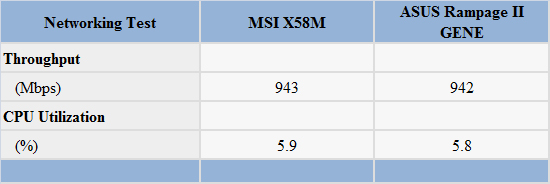
Since both motherboards utilize the same Realtek RTL8111C controller, the results are equal for the most part.
First Thoughts
We are actually at a loss for words to be honest. At a $169.99 price tag, we expected a motherboard lacking in features compared to the more expensive X58 offerings, with average performance at best. MSI has now shown us that you do not need to spend $250~$300 for an X58 motherboard to get a full feature set along with well balanced performance. The X58M is perfectly happy operating as the foundation for a high-end SOHO SFF media system or a high performance SFF gaming system. With the right case setup, this motherboard can be the centerpiece in a killer LAN Party system - or in our case, the crown jewel for a single home system that can do everything from media creation to gaming better than any other alternative CPU/chipset combination we can think of.
Based on our original experience with the MSI X58 Eclipse and Platinum motherboards, we really did not expect much in the way of improvements in clocking or performance. You can imagine our surprise after using this board for the last two weeks. It is has proven to be a very stable motherboard with excellent performance. Do you want to boot your latest 920 D0 at 21x230? No problem, the board handles it without breaking a sweat. Do you need to overclock while keeping your CPU core Vid at less than 1.00V in load conditions? Once again, this board will handle that requirement with aplomb and offers a multitude of options to accomplish it.
Of course, not every board is perfect and this one does have a couple items that bother us. The first problem is that S3 resume does not work properly with Bclk settings above ~150 at this time. MSI is working diligently to remedy that situation but by now, this is something any X58 motherboard should handle with ease. We do not care for the placement of the two chassis fan headers as most double slot video cards will create problems with their usage. They are usable (barely at times), but it requires some forethought when installing the board and components. In addition, both of these fan headers lack proper speed and temperature controls and for a uATX board targeted to the SFF market, this is something we do not like. The PWM area requires proper air cooling in heavy overclock situations as MSI did not provide a heatsink for passive cooling.
The board tends to slightly overvolt VTT and at times VDimm, but load voltages are correct on our review sample. There are also some inconsistencies in the BIOS feature descriptions and we would have preferred tighter tRFC timings at DDR3-1333/DDR3-1600 speeds. On the pure wish list, we would like to see an additional two USB headers on the I/O panel and a nice black PCB to match the blue/black design scheme on the various connectors and slots. The overclocking Bclk switch should be replaced with a reset button or ideally both a reset button and clear CMOS button. We understand certain sacrifices have to be made to meet this price point and so our list of potential improvements does not concern us greatly, except for the S3 resume problem.
All that aside, we think MSI has a winner here. The price is right, the quality is great, performance is terrific, and the feature set (CrossFire/SLI) matches that of boards costing up to a hundred dollars more. We have no problem recommending the MSI X58M at this point and look forward to seeing it again in our roundup.





















